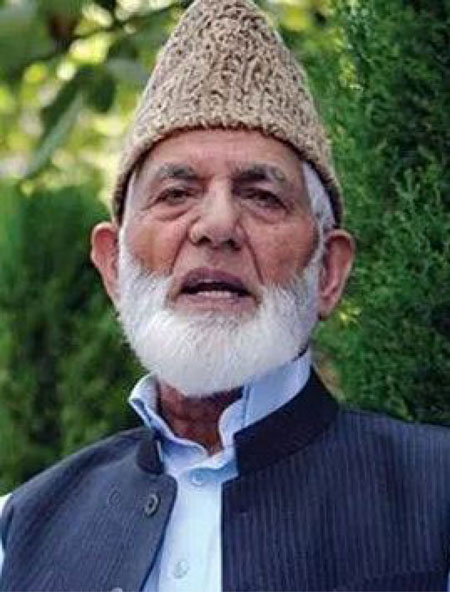What India under Modi is doing in Indian illegally occupied Jammu and Kashmir has attested the unchallenging capability of towering Kashmiri personality, Syed Ali Gilani , to foresee anti-Kashmir’s measures years before they are now unfolding in the territory, said a study conducted by Kashmir Media Service.
Sagacity of Syed Ali Gilani, the report added, was once again proven when the incumbent Bharatiya Janata Party-led Indian government announced to include the Indian citizens ordinarily residing in IIOJK in voter lists three years after its unilateral moves to annex IIOJK on 5 August 2019 in complete disregard to the United Nations Security Council Resolutions and bilateral agreements between India and Pakistan. The moves are aimed at diluting the disputed status of the territory and to change its Muslim majority character.
Syed Ali Gilani had rightly pointed out, before hand, the Indian measures for demographic engineering including land grab and setting up of colonies for Indian soldiers and Kashmiri Pandits, issuing new domicile rules, delimitation of Assembly constituencies and voting rights to non-resident Kashmiris in elections.
Some of the following anti-Kashmiris’ measures taken by the Modi regime speak volumes for the ability of Syed Ali Gilani to foresee things;
On the legal front, India eroded special status of Jammu and Kashmir by repealing the Article 370 and carving out two union territories to be governed directly from New Delhi.
The marginalization of Muslim majority population in Kashmir, policies of land-grab, exploitation of natural resources, rampant aggression, killings, arbitrary arrests, extra-judicial executions, forced disappearances and systematic genocide of Kashmiri youth by the Indian troops are obvious manifestations of the racist regime’s apocalyptic vision and attitude towards Kashmir and the Kashmiris, the KMS study said.
India’s unilateral moves in Kashmir have not only created serious problems for final settlement of the Kashmir dispute but also spurred tensions between two nuclear states putting the regional peace and security at risk.
The veteran Hurriyat leader, Syed Ali Gilani, had correctly predicted that India was planning to bring 500,000 Indian labourers from Bihar, Rajasthan and other Indian states in Kashmir to permanently settle them there, they hailed the vision of the late Kashmiri leader.
In addition to this, Syed Ali Gilani had said that Indian soldiers would be granted citizenship of Kashmir while 300,000 to 500,000 displaced persons will be settled in Kashmir and Kashmiri Hindus (Pandits) will be settled in separate zones as well.
Gilani had foretold what future beholds for Kashmir in many of his revolutionary and visionary speeches. He had said when demography will be changed in favor of Hindus in Kashmir like in Jammu then India may concede to plebiscite in the territory. It is feared that the Modi regime may accept the plebiscite once its settler plan is accomplished, the report concluded.
Like Quaid-e-Azam Muhammad Ali Jinnah, Quaid-e-Kashmir Syed Ali Gilani had also drawn the conclusion from the past events that Hindus would never accept Muslims as an entity in India and a majority population in IIOJK. Gilani knew that the Hindutva forces who conducted massacre of Muslims in Jammu might repeat the same in the Kashmir valley, once India is ruled by RSS and its sister organizations. It is because the record of large scale killing of Muslim population, at the time of partition of Sub-Continent in 1947, mainly in the Jammu region of the State is well documented. Lacs of Muslims were either killed or forced to migrate from Jammu region in the month of November in 1947.
The KMS report mentioned the land grab by occupational forces on different occasions said after the start of the indigenous liberation struggle in Kashmir in 1989, a large number of Kashmiri Pandits migrated from Kashmir with active support from the Indian government while leaving behind their homes and properties. These left-over properties were mostly grabbed by Indian forces’ personnel. In addition to this, the Indian forces also occupied a large number of privately-owned properties, government property, forest and agriculture land, etc. It is estimated that more than 2,800,000 kanals of land was grabbed by the Indian forces in Kashmir. The forces’ personnel also got hold of tourist spots like Toasmaidan, Gulmarg, Pahalgam, Bangus Valley, etc.
To change the demographic composition of Jammu and Kashmir, Indian government came up with a plan in 2016 for setting up Sainik (soldier) colonies in various parts of the Kashmir valley, which was perceived as RSS agenda of settling outsiders in Jammu and Kashmir. In July 2019, the ruling BJP hinted at reviving its plan for resettlement of 200,000 to 300,000 Kashmiri Pandits (Hindus) in the Kashmir valley. It said that these Pandits would be settled in specifically constructed segregated Hindu enclaves.
According to the report, 5,764 families or 47,215 people had migrated from Pakistan (not Azad Jammu and Kashmir) and these families had settled in Jammu, Kathua and Rajouri districts. They are called West Pakistan Refugees (WPRs) and are Hindus. In 2015, the Indian parliamentary standing committee on home affairs recommended refugees the status of permanent residents with the right to vote in the state assembly elections as they did not have such privilege earlier. The main apprehension of the Kashmir’s political leadership is that these settlements will change the status of Kashmir as Muslim majority state. Due to resistance from local Kashmiris, the Indian government was not able to implement this plan. However, after the scrapping of Article 370 on 5 August 2019, the WPRs can now purchase land and apply for jobs in IIOJK, besides, they can vote and contest elections in the occupied territory.
The three-member Delimitation Commission on Jammu and Kashmir, headed by Justice (retd) Ranjana Desai, signed its final order redrawing the Union territory’s assembly constituencies on 5 May, 2022, a day before its term was to end. —KMS










